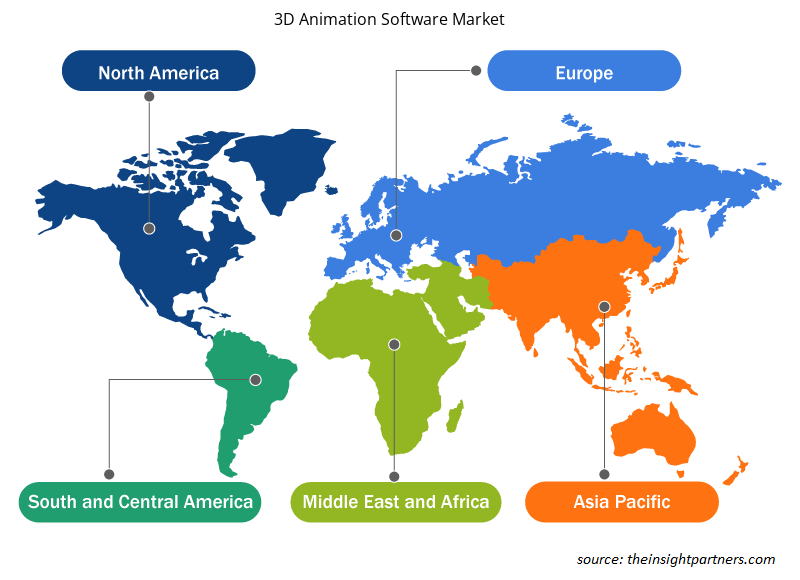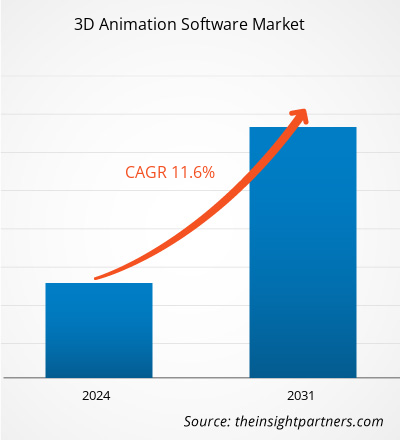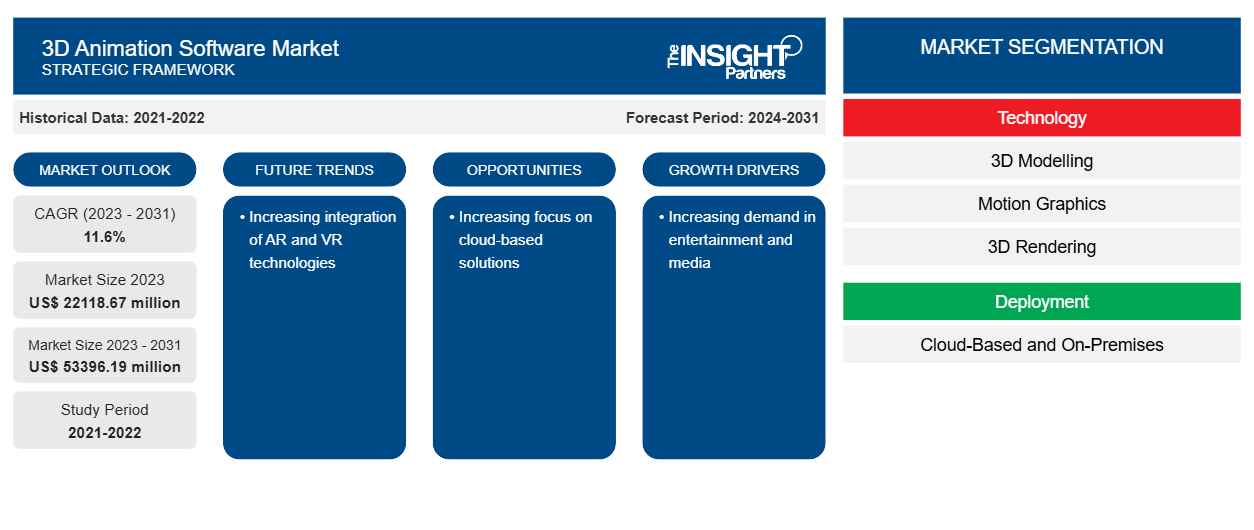Le marché des logiciels d'animation 3D devrait atteindre 53 396,19 millions USD d'ici 2031, contre 22 118,67 millions USD en 2023. Le marché devrait enregistrer un TCAC de 11,6 % au cours de la période 2023-2031. L'intégration croissante des technologies AR et VR devrait rester une tendance clé du marché.
Analyse du marché des logiciels d'animation 3D
Les principaux facteurs à l’origine de la croissance du marché des logiciels d’animation 3D comprennent la tendance croissante de la réalité virtuelle (VR) et de l’intelligence artificielle (IA), ainsi que la demande croissante d’applications et de jeux mobiles 3D. En outre, les avancées technologiques importantes et l’utilisation accrue de logiciels d’animation à des fins éducatives et universitaires stimulent la croissance du marché des logiciels d’animation 3D. Le rapport sur le marché des logiciels d’animation 3D donne une étude détaillée des divers facteurs moteurs et des tendances à venir contribuant à la prolifération du marché des logiciels d’animation 3D.
Aperçu du marché des logiciels d'animation 3D
Un logiciel d'animation 3D est un programme d'imagerie générée par ordinateur (CGI) permettant de visualiser, de générer et de modifier des images et des animations 3D statiques et dynamiques. Grâce à de nombreuses technologies, telles que les effets visuels (VFX), la modélisation 3D , les graphiques animés et le rendu 3D, le programme mélange des séquences vidéo et des images artificielles pour créer des objets et des situations réalistes. Il est fréquemment utilisé pour générer des effets créatifs dans les publicités de marque et les promotions de produits, pour visualiser des informations scientifiques, sur les produits et les systèmes et pour effectuer des analyses visuelles. Il a plusieurs applications dans des secteurs tels que les médias et le divertissement, l'architecture, la santé et les sciences de la vie.
Personnalisez ce rapport en fonction de vos besoins
Vous bénéficierez d'une personnalisation gratuite de n'importe quel rapport, y compris de certaines parties de ce rapport, d'une analyse au niveau des pays, d'un pack de données Excel, ainsi que de superbes offres et réductions pour les start-ups et les universités.
-
Obtenez les principales tendances clés du marché de ce rapport.Cet échantillon GRATUIT comprendra une analyse de données, allant des tendances du marché aux estimations et prévisions.
Moteurs et opportunités du marché des logiciels d'animation 3D
Demande croissante en matière de divertissement et de médias
Les logiciels d'animation 3D sont largement utilisés comme logiciels d'animation 3D de référence dans les secteurs du jeu, du cinéma, des médias et du divertissement. Ces outils d'animation prennent en charge les flux de travail polygonaux et de sculpture. L'animation de personnages est l'un de ses principaux atouts, grâce à ses fonctionnalités de rigging et d'animation d'images clés. Il prend également en charge les entrées provenant de logiciels de capture de mouvements, ce qui en fait un favori pour les équipes qui ont besoin de capturer des mouvements très réalistes pour les personnages. Par conséquent, la demande pour de tels logiciels augmente dans le secteur du divertissement et des médias.
L'accent est mis de plus en plus sur les solutions basées sur le cloud
Diverses entreprises prennent des initiatives stratégiques pour lancer des logiciels d'animation 3D basés sur le cloud, telles que des partenariats, des acquisitions, etc. Par exemple, en mai 2024, Autodesk, Inc. a annoncé l'acquisition de Wonder Dynamics, créateur de Wonder Studio, une solution d'animation 3D et d'effets visuels basée sur le cloud qui combine l'intelligence artificielle (IA) avec des outils établis. De même, en avril 2024, Andreas Wanda, spécialiste australien de l'industrie des effets visuels et de la postproduction, a lancé Atmos, un nouveau studio d'animation et d'effets visuels basé sur le cloud qui fournit des services de solutions de postproduction entièrement à distance pour les films diffusés, la télévision et le contenu en ligne. Ainsi, l'adoption croissante des véhicules électriques crée davantage d'opportunités pour le marché.
Analyse de segmentation du rapport sur le marché des logiciels d'animation 3D
Les segments clés qui ont contribué à l’élaboration de l’analyse du marché des logiciels d’animation 3D sont la technologie, le déploiement et l’application.
- En fonction de la technologie, le marché des logiciels d'animation 3D est divisé en modélisation 3D, animation graphique, rendu 3D, effets visuels (VFX) et autres. Le segment des solutions détenait une part de marché plus importante en 2023.
- En termes de déploiement, le marché est segmenté en cloud et sur site. Le segment cloud détenait une part de marché plus importante en 2023.
- En fonction du matériel d'application, le marché est segmenté en médias et divertissement, soins de santé et sciences de la vie, fabrication, éducation et recherche, et autres.
Analyse des parts de marché des logiciels d'animation 3D par zone géographique
La portée géographique du rapport sur le marché des logiciels d’animation 3D est principalement divisée en cinq régions : Amérique du Nord, Asie-Pacifique, Europe, Moyen-Orient et Afrique, et Amérique du Sud et centrale.
L'Amérique du Nord détient la plus grande part de marché des logiciels d'animation 3D. La croissance du marché dans cette région est attribuée à l'augmentation de l'utilisation de technologies de pointe dans les secteurs de la santé et des sciences de la vie, des médias et du divertissement, de l'éducation et de l'enseignement. L'utilisation croissante d'effets visuels dans les films, les applications mobiles et les jeux contribue au marché des logiciels d'animation 3D en Amérique du Nord.
Aperçu régional du marché des logiciels d'animation 3D
Les tendances et facteurs régionaux influençant le marché des logiciels d’animation 3D tout au long de la période de prévision ont été expliqués en détail par les analystes d’Insight Partners. Cette section traite également des segments et de la géographie du marché des logiciels d’animation 3D en Amérique du Nord, en Europe, en Asie-Pacifique, au Moyen-Orient et en Afrique, ainsi qu’en Amérique du Sud et en Amérique centrale.

- Obtenez les données régionales spécifiques au marché des logiciels d'animation 3D
Portée du rapport sur le marché des logiciels d'animation 3D
| Attribut de rapport | Détails |
|---|---|
| Taille du marché en 2023 | 22118,67 millions de dollars américains |
| Taille du marché d'ici 2031 | 53396,19 millions USD |
| Taux de croissance annuel composé mondial (2023-2031) | 11,6% |
| Données historiques | 2021-2022 |
| Période de prévision | 2024-2031 |
| Segments couverts |
Par technologie
|
| Régions et pays couverts |
Amérique du Nord
|
| Leaders du marché et profils d'entreprises clés |
|
Densité des acteurs du marché des logiciels d'animation 3D : comprendre son impact sur la dynamique commerciale
Le marché des logiciels d'animation 3D connaît une croissance rapide, tirée par la demande croissante des utilisateurs finaux en raison de facteurs tels que l'évolution des préférences des consommateurs, les avancées technologiques et une plus grande sensibilisation aux avantages du produit. À mesure que la demande augmente, les entreprises élargissent leurs offres, innovent pour répondre aux besoins des consommateurs et capitalisent sur les tendances émergentes, ce qui alimente davantage la croissance du marché.
La densité des acteurs du marché fait référence à la répartition des entreprises ou des sociétés opérant sur un marché ou un secteur particulier. Elle indique le nombre de concurrents (acteurs du marché) présents sur un marché donné par rapport à sa taille ou à sa valeur marchande totale.
Les principales entreprises opérant sur le marché des logiciels d'animation 3D sont :
- Adobe
- Autodesk Inc.
- Société Corel
- EIAS3D
- Maxon Corporation GmbH
- SideFX
Avis de non-responsabilité : les sociétés répertoriées ci-dessus ne sont pas classées dans un ordre particulier.

- Obtenez un aperçu des principaux acteurs du marché des logiciels d'animation 3D
Actualités et développements récents du marché des logiciels d'animation 3D
Le marché des logiciels d'animation 3D est évalué en collectant des données qualitatives et quantitatives après des recherches primaires et secondaires, qui incluent d'importantes publications d'entreprise, des données d'association et des bases de données. Quelques-uns des développements du marché des logiciels d'animation 3D sont répertoriés ci-dessous :
- DeepMotion, leader de longue date dans le domaine de la technologie de capture de mouvement basée sur l'IA, annonce MotionGPT™, un outil révolutionnaire qui exploite la puissance de l'IA générative pour transformer les invites de texte en animations 3D complexes. MotionGPT simplifie non seulement le processus de création d'animations, mais transcende également les barrières physiques, permettant à un public plus diversifié de créateurs et d'industries de bénéficier d'une animation 3D simple et rentable. (Source : DeepMotion, communiqué de presse, septembre 2023)
- Kinetix, start-up deep tech et pionnière de l’animation 3D assistée par l’IA, étoffe sa bibliothèque d’assets 3D en s’associant à Adobe. Sa technologie no-code unique permet de générer automatiquement et instantanément des personnages 3D animés à partir d’une simple vidéo 2D, et s’enrichit aujourd’hui d’une sélection inédite d’animations et de personnages Mixamo de l’éditeur de logiciels. Cette collaboration rapproche ainsi la start-up française de son objectif de rendre la 3D animée et instantanée accessible au plus grand nombre de créateurs, qu’ils soient professionnels ou amateurs. (Source : Kinetix, Communiqué de presse, mars 2022)
Rapport sur le marché des logiciels d'animation 3D : couverture et livrables
Le rapport « Taille et prévisions du marché des logiciels d’animation 3D (2021-2031) » fournit une analyse détaillée du marché couvrant les domaines ci-dessous :
- Taille et prévisions du marché des logiciels d'animation 3D aux niveaux mondial, régional et national pour tous les segments de marché clés couverts par le périmètre
- Tendances du marché des logiciels d'animation 3D ainsi que la dynamique du marché telles que les moteurs, les contraintes et les opportunités clés
- Analyse détaillée des cinq forces de PEST/Porter et SWOT
- Analyse du marché des logiciels d'animation 3D couvrant les principales tendances du marché, le cadre mondial et régional, les principaux acteurs, les réglementations et les développements récents du marché
- Analyse du paysage industriel et de la concurrence couvrant la concentration du marché, l'analyse de la carte thermique, les principaux acteurs et les développements récents du marché des logiciels d'animation 3D
- Profils d'entreprise détaillés
- Analyse historique (2 ans), année de base, prévision (7 ans) avec TCAC
- Analyse PEST et SWOT
- Taille du marché Valeur / Volume - Mondial, Régional, Pays
- Industrie et paysage concurrentiel
- Ensemble de données Excel
Rapports récents
Rapports connexes
Témoignages
Raison d'acheter
- Prise de décision éclairée
- Compréhension de la dynamique du marché
- Analyse concurrentielle
- Connaissances clients
- Prévisions de marché
- Atténuation des risques
- Planification stratégique
- Justification des investissements
- Identification des marchés émergents
- Amélioration des stratégies marketing
- Amélioration de l'efficacité opérationnelle
- Alignement sur les tendances réglementaires























 Obtenez un échantillon gratuit pour - Marché des logiciels d'animation 3D
Obtenez un échantillon gratuit pour - Marché des logiciels d'animation 3D